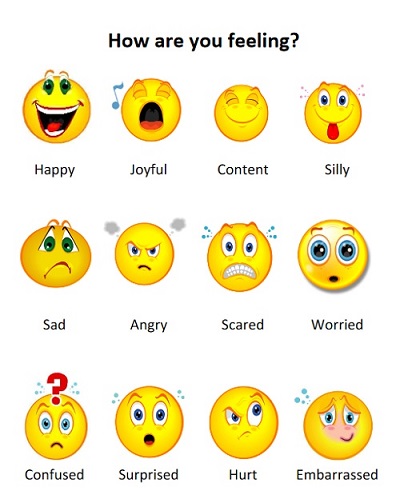Teaching Kids Healthy Ways to Express Their Feelings
by Kathy Slattengren, M. Ed., Priceless Parenting (sign up for monthly parenting newsletter and receive 20+ printable charts for kids and parents)
(listen to article read by the author)

Your kids will experience a wide range of emotions each day. They may feel elated one moment followed by disappointment in the next moment. Perhaps they are thrilled with the red helium balloon they’ve just been given, only to experience dismay when they forget to hold on and the balloon floats away. Or they may feel terrified in asking someone to the dance and then exhilarated when that person says yes.
Part of being human is experiencing all these different emotions. How your children learn to handle their feelings will affect their success in relationships and school.
How To Teach A Child To Express Feelings
When your kids are young, they need your help in labeling their feelings. If your child is stomping his feet and snarling as he tries to zip up his jacket, you might comment “
It looks like you are frustrated with trying to zip up your jacket. I feel frustrated too when things are hard to do.” Hearing this helps your child feel noticed while also learning a word to attach to his feelings.
Developing a vocabulary for describing feelings gives children words for their emotional experiences. Understanding their own feelings then allows them to appreciate other people’s feelings. Correctly reading other people’s feelings is essential for building relationships.
A chart with faces and labels can help children see the differences in feelings. A
feelings chart can be used for kids to point to the face that best matches how they are currently feeling. Pictures that go along with stories are also a wonderful way to talk about what the character might be feeling.
Older kids are ready for a range of
words to describe mild to strong feelings. Are they furious, angry or feeling slightly bugged? Identifying the feeling’s intensity is important in communicating and figuring out what action to take.
Listening to your children’s feelings is often the most helpful thing you can do. Talking through big feelings helps kids sort out what’s going on. You don’t have to fix anything, just listen.
Feelings Are Fine, Some Expressions of Feelings Are Not OK
Feelings drive behavior. Part of maturing is being able to respond reflectively rather than reflexively in situations involving strong feelings. Kids need plenty of practice to learn to handle negative feelings well.
While everyone has a right to their feelings, they do not have the right to express those feelings in ways that hurt others. For example, these are some inappropriate expressions of feelings:
- “You’re stupid!”
- “You’re a mean Mommy!”
- “I hate you!”
- Hitting, biting, shoving, kicking
- Posting mean comments on social media
When children choose inappropriate behavior, start by acknowledging the feeling you believe is behind the behavior. For example, “You are angry that your brother took your truck so you hit him.” Next suggest a better way to express the emotion, “
It’s not OK to hit him. You can tell him you are angry and let him know what you want him to do.”
Feelings are neither right nor wrong. For example, if teens are feeling rejected by peers, their feelings are valid. Listening to them talk about how they are feeling can help them process those feelings and decide what action to take. How they choose to act on those feelings may or may not be OK.
Trying To Avoid Negative Feelings Is Costly
Everyone experiences emotional pain; it’s part of being human. It’s also very human to try to avoid these negative feelings by numbing them. What your kids may not realize is that numbing the painful emotions also numbs the positive ones.
Trying to avoid emotional pain may lead to disastrous results. Some harmful ways kids try to numb emotional pain include things like:
- Drinking, taking drugs
- Cutting oneself
- Seriously restricting food intake
- Injuring someone else or an animal
- Committing suicide
While these actions may temporarily or permanently numb the emotional pain, teaching kids to honestly express their difficult emotions gives them better options. When you allow kids to express their negative feelings, they learn how to talk through their pain rather than try to bury it. Is it easy to listen to someone else’s pain? No!
Saying things like “
Stop crying!” or “
You’re not really hurt.” teaches kids that expressing emotions like sadness or anger is not OK. However, when children's feelings are validated, they feel understood and recover more quickly. They learn that they can handle difficult feelings and eventually experience relief.
Remember your job is to listen to your children, not to solve their problems. They need to figure out what action to take although you may be able to help them think through consequences of the actions they are considering. Being able to trust you with their most difficult feelings is a life-long gift for your children. You can provide hope and guidance as they maneuver through life’s inevitable challenges.